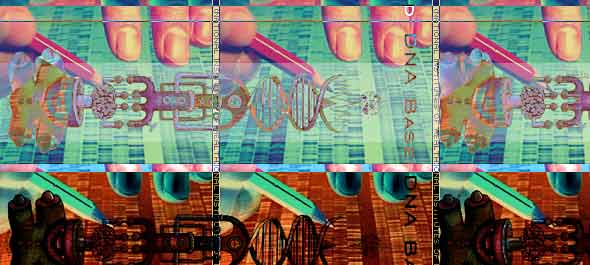BY LETTER
CRISPR-Cas Gene Editing
 Image from Bernd Helfert |
Information Age genetic manipulation technology which utilized proteins derived from microbes to make precise changes to an organism's genome. The acronym CRISPR stands for Clustered Regularly Interspaced Short Palindromic Repeats, describing the characteristic patterns in bacterial genomic DNA which led to the initial discovery of their associated systems of DNA- and/or RNA-manipulating proteins (referred to as Cas, or CRISPR-associated proteins).
In their natural context, CRISPR systems act as bacterial and archaeal defense mechanisms against viruses and other mobile genetic elements that commonly infect microbes. CRISPR arrays contain short DNA sequences which have previously been "clipped" from the genetic material of an invading virus, and subsequently inserted by specialized proteins into a short palindromic sequence (i.e. a CRISPR) located in the host genome. These virus-derived sequences are then used as templates for small RNA molecules, known as guide RNAs, which each form a complex with one or more Cas proteins. Once "programmed" with a guide RNA, the Cas protein will move via diffusion throughout the cell until it encounters foreign DNA, which it will then unwind so as to separate the strands of its double helix and allow the nucleotides making up its guide RNA to attempt to base-pair with those making up one of the exposed strands. If the guide RNA sequence is fully complementary to the foreign DNA sequence under interrogation, the Cas protein will "recognize" it as belonging to the same type of virus from which the guide RNA sequence was originally derived, and will proceed to cleave both strands of DNA via hydrolysis, thus rendering the virus unable to replicate itself.
Shortly after these systems were discovered during the early Information Age, molecular biologists of the time realized that the programmable DNA-cutting activity of Cas proteins could very easily be repurposed to enable precise genetic manipulations. By targeting a Cas protein to a particular DNA sequence in a eukaryotic cell, thus cutting the DNA at that specific location, they could then allow the cell's own DNA repair mechanisms to re-join the broken ends, in the process reliably introducing random single-nucleotide alterations at the repair site that could correct an unwanted mutation (e.g. a mutant allele associated with a genetic disorder) or render a gene inactive. With a few additional steps, they could also insert new DNA sequences into the cut site, or fuse Cas proteins with various other DNA-modifying enzymes to enable yet more precise modifications that did not require the target DNA to be cut at all. No other genetic engineering method prior to this exhibited nearly the same level of ease, versatility and precision for making changes to the genome of a living organism.
The invention (some would say "discovery," as most of the key components were already present in nature) of CRISPR-Cas gene editing sparked a revolution in the biological sciences and biotech industry in the middle First Century AT. Initially restricted to scientific research and biomedical applications such as the treatment of serious genetic disorders, in the centuries that followed gene editing gradually made its way into the consumer marketplace, as companies emerged selling CRISPR-based health fixes and cosmetic modifications mediated by non-heritable gene edits. While modifications to the human germline were strictly prohibited by both international and regional laws for much of this period, eventually these began to relax, at first leading to a proliferation of "designer baby" services targeted to the very wealthy, and later enabling the creation of what are now considered to have been the very first tweaks.
The relative simplicity of the CRISPR-Cas technique also meant that it was easily picked up by amateur gengineers, who busily set to work making (often illegal) modifications to their own genomes and those of various animals, plants and other organisms. The resulting profusion of unregulated and often uncontrollable gene-edited organisms during this period was one of many contributing factors to the general disorder throughout global society which preceded and eventually helped to bring about the Technocalypse.
Today, CRISPR-Cas gene editing has long been supplanted by gene-editing nanotechnology, which allows for almost total control over a given organism's genome. However, CRISPR systems (either natural or modified) are still an integral component of many examples of bionano even today, and Cas proteins are generally acknowledged by historians as one of the first examples of bionanites to be developed by Terragen Civilization.
Related Articles
- Bionano, Bionanotechnology
- Biotech - the Early Years
- Genestick
- GeneTEK
- Genetic Algorithm - Text by Anders Sandberg in his Transhumanist Terminology
Any algorithm which seeks to solve a problem by considering numerous possibilities at once, ranking them according to some standard of fitness, and then combining ("breeding") the fittest in some way. In other words, any algorithm which imitates natural selection. - Genetic Encryption
- Genetics - Text by M. Alan Kazlev
The study of heredity, genes, and the genome, both terragen and alien (this latter is sometimes called xenogenetics). Includes also the mapping of the genotype with the phenotype, simulation of past and future inheritance and evolutionary paths, and the basic theory behind gengineering. - Gengineer, Geneer (profession)
- Genome
- Genotype - Text by M. Alan Kazlev; additions by Stephen Inniss
Hereditary constitution of an individual; its genome (or equivalent, in artificial neumann-capable organisms or in xenobionts). Contrast with phenotype. - Genotypic Augmentation - Text by M. Alan Kazlev
Modification or augmentation that effects only the genotype of the gametes and descendants of an organism. Genotypic augmentation is biological or genetic modification or augmentation that effects only the genotype of the gametes and descendants of an organism. It does not alter the characteristics of the user, or of clones from the user's somatic cells, but it does modify that of all of the user's offspring. Contrast with phenotypic augmentation. - Technocalypse
Appears in Topics
Development Notes
Text by Andrew P
Initially published on 27 June 2024.
Initially published on 27 June 2024.






